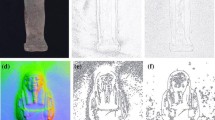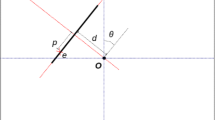Abstract
This paper lays the theoretical foundations to path openings and closings.
The traditional morphological filter used for the analysis of linear structures in images is the union of openings (or the intersection of closings) by linear segments. However structures in images are rarely strictly straight, and as a result a more flexible approach is needed.
An extension to the idea of using straight line segments as structuring elements is to use constrained paths, i.e. discrete, one-pixel thick successions of pixels oriented in a particular direction, but in general forming curved lines rather than perfectly straight lines. However the number of such paths is prohibitive and the resulting algorithm by simple composition is inefficient.
In this paper we propose a way to compute openings and closings over large numbers of constrained, oriented paths in an efficient manner, suitable for building filters with applications to the analysis of oriented features, such as for example texture.
Similar content being viewed by others
References
M. Buckley and H. Talbot, “Flexible linear openings and closings” inMathematical Morphology and its Application to Image Analysis, L. Vincent and D. Bloomberg (Eds.), Palo Alto, ISMM, Kluwer, June 2000.
H.J.A.M. Heijmans,Morphological Image Operators, Academic Press: Boston, 1994.
H.J.A.M. Heijmans, “Morphological filters for dummies” inMathematical Morphology and its Applications to Image and Signal Processing, Petros Maragos, Ronald W. Schafer, and Muhammad A. Butt (Eds.), Atlanta, GA, Proceedings for ISMM’96, Kluwer Acad., May 1996, pp. 127–137.
C. Ronse, “Extraction of narrow peaks and ridges in images by combination of local low rank and max filters: Implementation and applications to clinical angiography” Working Document WD47, Philips Research Laboratories, Brussels, Belgium, 1988.
J. Serra,Image Analysis and Mathematical Morphology, Academic Press: London, 1982.
J. Serra (Ed.),Image Analysis and Mathematical Morphology. II: Theoretical Advances, Academic Press: London, 1988.
P. Soille,Morphological Image Analysis, Principles and Applications, Springer, 1999.
P. Soille and H. Talbot, “Directional morphological filtering” IEEE Transactions on Pattern Analysis and Machine Intelligence, Vol. 23, No. 11, pp. 1313–1329, 2001.
M. Vandroogenboeck and H. Talbot, “Fast computation of morphological operations with arbitrary structuring elements”Pattern Recognition Letters, Vol. 17, pp. 1451–1460, 1996.
L. Vincent, “Minimal path algorithms for the robust detection of linear features in images” inMathematical Morphology and its Applications to Image and Signal processing, vol. 12 ofComputational Imaging and Vision, Amsterdam, Kluwer, Proceedings for ISMM’98, June 1998, pp. 331–338.
Author information
Authors and Affiliations
Corresponding author
Additional information
This paper was written at CSIRO MIS while on leave from CWI.
Henk Heijmans was born in 1957 in Tilburg, The Netherlands. After obtaining his masters degree in mathematics from the Technical University in Eindhoven, he went to the Centre for Mathematics and Computer Science where he became a PhD student working in the area of mathematical biology. He received his PhD degree from the University of Amsterdam in 1985. Currently Henk Heijmans is heading the “Signals and Images” research group (PNA4) at CWI, Amsterdam, The Netherlands. The aim of this research theme is to combine expertises in various directions in signal and image analysis, in which mathematics and computer science play an essential role, thereby contributing to solutions of important problems for society in the coming years. His own research interests are focused towards mathematical techniques for image and signal processing, with an emphasis on mathematical morphology and wavelet analysis.
Michael Buckley is a Principal Research Scientist at CSIRO, Mathematical and Information Sciences, with the Biotechnology and Health Informatics research program. He has a Ph.D. in Mathematical Statistics. In recent years Michael has published several papers on microarray normalisation. In 2003–2004 he has worked in proteomics, including protein chips, LC-MS-MS and biomarker discovery. He has substantial experience in dynamic programming, Hidden Markov Models and related methods for matching and modelling amino acid or nucleotide sequences. He has also worked in the field of image analysis, including the Road Crack project where he was the technical leader of algorithm development, collaborations with Axon Instruments Inc. and analysis of cDNA microarray images.
Hugues Talbot received the engineering degree from École Centrale de Paris in 1989, the D.E.A. (Masters) from University Paris VI in 1990 and the Ph.D from École des Mines de Paris in 1993, under the guidance of Dominique Jeulin and Jean Serra. He has been a scientist with the Commonwealth Scientific and Industrial Research Organisation (CSIRO), Mathematical and Information Sciences since 1994. He has worked on numerous applied projects in relation with industry, has contributed more than 30 research papers in international journals and conferences and has co-edited two sets of international conference proceedings on image analysis. He was the general chair for DICTA’2003, the largest regular image processing conference in Australia. He now also teaches image processing at the University of Sydney, and his research interests include image segmentation, linear structure analysis, texture analysis and algorithms.
Rights and permissions
About this article
Cite this article
Heijmans, H., Buckley, M. & Talbot, H. Path Openings and Closings. J Math Imaging Vis 22, 107–119 (2005). https://doi.org/10.1007/s10851-005-4885-3
Issue Date:
DOI: https://doi.org/10.1007/s10851-005-4885-3




